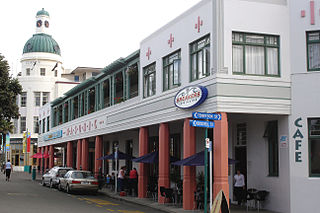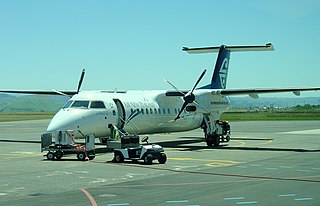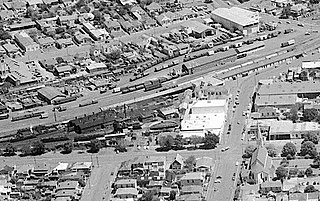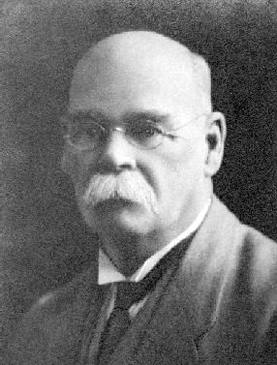Related Research Articles

Hawke's Bay is a region on the east coast of New Zealand's North Island. The region is named for Hawke Bay, which was named in honour of Edward Hawke. The region's main centres are the cities of Napier and Hastings, while the more rural parts of the region are served by the towns of Waipukurau, Waipawa, and Wairoa.

Napier is a city on the eastern coast of the North Island of New Zealand and the seat of the Hawke's Bay region. It is a beachside city with a seaport, known for its sunny climate, esplanade lined with Norfolk pines, and extensive Art Deco architecture. For these attributes, Napier is sometimes romantically referred to as the "Nice of the Pacific".

The 1931 Hawke's Bay earthquake, also known as the Napier earthquake, occurred in New Zealand at 10:47 am on 3 February, killing 256, injuring thousands and devastating the Hawke's Bay region. It remains New Zealand's deadliest natural disaster. Centred 15 km north of Napier, it lasted for two and a half minutes and had a magnitude of 7.8 Ms. There were 525 aftershocks recorded in the following two weeks, with 597 being recorded by the end of February. The main shock could be felt in much of New Zealand, with reliable reports coming in from as far south as Timaru, on the east coast of the South Island.

Hastings is an inland city of New Zealand and is one of the two major urban areas in Hawke's Bay, on the east coast of the North Island. The population of Hastings is 52,200, with a further 14,900 people in Havelock North and 2,120 in Clive. Hastings is about 18 kilometres inland of the coastal city of Napier. These two neighbouring cities are often called "The Bay Cities" or "The Twin Cities".
Waipukurau is the largest town in the Central Hawke's Bay District on the east coast of the North Island of New Zealand. It is located on the banks of the Tukituki River, 7 kilometres south of Waipawa and 50 kilometres southwest of Hastings.

The Hawke's Bay Rugby Union (HBRU) is the governing body of rugby union in the Hawke's Bay region of New Zealand. The union is based in Napier.

Hawke's Bay Airport, commonly referred to as Napier Airport, is Hawke's Bay's main commercial airport, serving domestic flights to the main centres of Auckland, Wellington and Christchurch, and smaller centres such as Gisborne. The airport is located in the north of Napier and 20.7 km from Hastings.

The Hawke's Bay cricket team, representing the Hawke's Bay region of New Zealand, played first-class cricket between 1883–84 and 1920–21, and competed in the Plunket Shield in the 1914–15 and 1920–21 seasons. The side has continued to appear in minor cricket and now competes in the Hawke Cup competition, where it has been the dominant team from 2020 to 2024.

Hawke's Bay Today is a daily compact newspaper published in Hastings, New Zealand and serving Hastings, Napier and the Hawke's Bay region. It is owned by APN News & Media. The Hawke's Bay Today is New Zealand's youngest newspaper, founded on 3 May 1999.

Napier is a New Zealand parliamentary electorate, returning one Member of Parliament to the House of Representatives. It is named after the city of Napier, the main urban area within the electorate. The electorate was established for the 1861 election and has existed since. It has been held by Katie Nimon of the New Zealand National Party since the 2023 general election. It was held by Stuart Nash of the New Zealand Labour Party from the 2014 general election until 2023, when he did not stand for re-election.
Hawke's Bay was a parliamentary electorate in the Hawke's Bay Region of New Zealand from 1881 to 1996. In 1986 it was renamed Hawkes Bay.
Frederick Sutton was a 19th-century Member of Parliament from the Hawke's Bay Region of New Zealand and an early settler, storekeeper and farmer in the area.
Amy Hadfield Hutchinson was a New Zealand school hostel matron, spinner and weaver, community leader.
The Hawke's Bay Herald-Tribune was a New Zealand newspaper which published from 1937 until 1999. Covering the Hawke's Bay region, it was based in Hastings.

The Napier railway station in Napier, New Zealand was the main railway station in Napier and an intermediate stop on the Palmerston North–Gisborne Line. On 12 October 1874 the station and the first section of the line south from Napier to Hastings was opened. The line through the Manawatū Gorge to Palmerston North and hence to Wellington was opened on 9 March 1891. The first train carrying passengers had been organised by the contractors, John Brogden and Sons, on Tuesday 30 June 1874 to run from Napier to Waitangi.
John Wolstenholme was a cricketer who played first-class cricket for Hawke's Bay from 1887 to 1898.

Charles Howard Edwards was a New Zealand cricketer who played two matches of first-class cricket for Hawke's Bay in 1884 and 1888.

Napier City Council is the territorial authority of Napier, a city in the Hawke's Bay region of New Zealand's North Island.

Rissington is a farming settlement 15 km (9.3 mi) north west of Napier, New Zealand. It lies in Hawke's Bay Region, between Sherenden and Napier, in the Mangaone River valley, on the road to Patoka and Puketitiri. A fire station, cemetery and a war memorial are the only remaining public structures, but it once had several more and was home to the country's first Women's Institute, co-founded by Amy Hutchinson and Bessie Spencer.

The Hawke's Bay Regiment was a territorial infantry regiment of the New Zealand Military Forces. The regiment traced its origins to the Napier Rifle Volunteer Rifles, a volunteer corps formed in 1863 and which would later amalgamate with other volunteer corps to form the 9th Regiment in 1911. During the First World War, the regiment provided a company to each of the battalions of the Wellington Infantry Regiment and saw combat at Galipolli and on the Western Front. After the war the regiment was renamed the Hawke's Bay Regiment and remained in New Zealand for home defense during the Second World War. Men from the regiment, however, served with the 19th, 22nd, 25th and 36th Battalions of the Second New Zealand Expeditionary Force. The regiment had a close relationship with the Ruahine Regiment, which was detached and reabsorbed by the Hawke's Bay regiment on two separate occasions. In 1964, the Hawkes Bay regiment was amalgamated with the Wellington Regiment and become the 7th Battalion, Royal New Zealand Infantry Regiment
References
- ↑ "Papers Past — The Daily Telegraph" . Retrieved 11 December 2012.